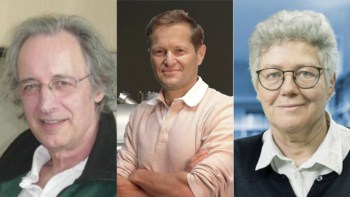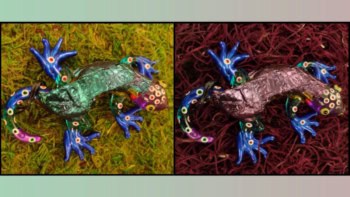
A new method for measuring distance based on an optical frequency comb has been unveiled by physicists in the Netherlands. The main benefit of the technique, which involves passing the light from an optical comb through a Michelson interferometer and analysing the resulting interference patterns, is that it allows distances to be measured accurately without already knowing the value to within half a wavelength of the light used. The technique could be used to measure the distance between satellites or to make very precise measurements of the dispersion of light in optical materials.
A Michelson interferometer consists of two optical paths – or arms – that are at right angles to each other. Incoming light strikes a beamsplitter where the two arms meet and light is sent simultaneously along each arm until it hits a mirror at the end of each path and is reflected back. The two beams are then recombined and sent to a screen, where an interference pattern appears if the two arms are different lengths. By analysing the pattern, the difference in length between the arms can be determined in terms of a fraction of the wavelength of the light.
Half-wavelength limit
In its simplest form, a Michelson interferometer is used with monochromatic light. However, this limits its effectiveness because, before a measurement is made, the length of the distance to be measured must be known to within one half of the wavelength (λ/2) of the light used – typically less than 500 nm. The problem is that the distance being measured can be expressed as an integer multiple of λ/2 plus a fraction of λ/2 – but this integer multiple cannot be determined from the interference data.
Physicists have found two ways round this problem. One is to use several lasers at different colours to gain more information about the system. The other is to use a light source with a range of wavelengths and then look for phase differences in the interfering light, which can be related to distance. These techniques have their own problems, not least that thousands of different lasers would ease a measurement but installing them all in a lab would be impractical.
9000 different lasers
What Steven van den Berg and colleagues at the National Metrology Institute in Delft and the Technical University of Delft have done is to combine the two techniques to allow even better distance measurements. The team makes use of a frequency comb – a device that outputs laser light at regularly spaced wavelengths. The result is that the interferometer is effectively being operated using about 9000 different lasers at the near infrared in the 808–828 nm range.
The researchers demonstrated their new technique by firing pulses from their frequency comb into an interferometer with a measurement arm about 15 cm long. After being recombined, the light from the two arms was passed through an optical device called an etalon and then reflected from an optical grating. Both of these devices change the trajectory of the light according to its wavelength, creating an interference pattern that was captured using a CCD camera. This image was then analysed to produce a plot of the intensity of light as a function of wavelength – with each data point corresponding to a different wavelength of the comb. The result is a sine wave from which the measured distance can be calculated.
The team found that the distance could be found to within λ/30 – or about 27 nm. While this is a typical result for a Michelson interferometer, the new set-up allows any distance that is already known to within 15 cm to be measured – compared with the 400 nm prior knowledge required by a monochromatic device.
Measuring optical properties
Van den Berg believes that the system could find uses in space, where light can travel long distances without interference. As such, he says it could be used to make extremely accurate measurements of the distances between satellites. The fact that the system makes very sensitive measurements across a range of wavelengths could also see it being used to measure the properties of optical materials – particularly how the index of refraction changes with wavelength.
The team is currently working on improving the stability of the system and also investigating how it performs over longer distances.
The work is described in Physical Review Letters.



